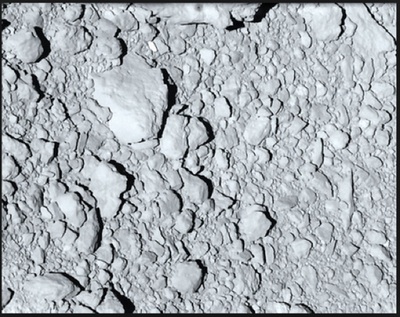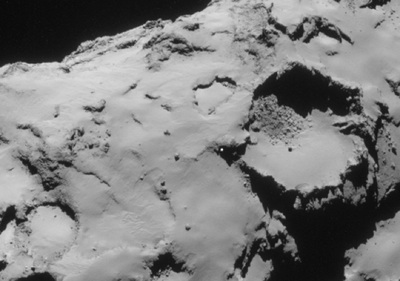
Powering cislunar spaceflight with NEO powderby Ronald P. Menich
|
| Our interest in near Earth objects should be more expansive than one or a few missions. |
It seems likely that NASA’s interest in such a mission is limited to executing it once or a few times to prove-out the technique, and to then move on to some other mission—perhaps a crewed trip to Mars—if and when funds become available. Within that limited ARM context, a conservative engineering approach using an existing deep-space propulsion system (e.g., xenon ion propulsion) to return the NEO to a lunar orbit, or High Earth Orbit (HEO) beyond geosynchronous orbit, will likely be chosen as a minimal risk approach.
Our interest in near Earth objects (NEOs) should be more expansive than one or a few missions, though. This essay examines an alternative propulsion system with substantial promise for future space industrialization using asteroidal resources returned to HEO.
Electrostatic propulsion is the method used by many deep space probes currently in operation such as the Dawn spacecraft presently wending its way towards the asteroid Ceres. For that probe and several others, xenon gas is ionized and then electrical potential is used to accelerate the ions until they exit the engine at exhaust velocities of 15–50 kilometers per second, much higher than for chemical rocket engines, at which point the exhaust is electrically neutralized. This method produces very low thrust and is not suitable for takeoff from planets or moons.
However, in deep space and integrated over long periods of engine operation time, the gentle push of an ion engine can impart a very significant velocity change to a spacecraft, and do so extremely efficiently: for the Deep Space 1 spacecraft, the ion engine imparted 4.3 kilometers per second of velocity change (delta-v), using only 74 kilograms of propellant to do so. As of late September, Dawn’s ion thrusters have produced 10.2 kilometers per second of delta-v, using 367 kilograms of xenon.
The solar system has planets, asteroids, rocks, sand, and dust, all of which can pose dangers to space missions. The larger objects can be detected in advance and avoided, but the very tiny objects cannot, and it is of interest to understand the effects of hypervelocity impacts of microparticles on spacesuits, instruments and structures. For over a half century, researchers have been finding ways to accelerate microparticles to hypervelocities (1 to 100 kilometers per second) in vacuum chambers here on Earth, slamming those particles into various targets and then studying the resultant impact damage. These microparticles are charged and then accelerated using an electrical potential field.
It is a natural step to consider, instead of atomic-scale xenon ions, the application to deep space propulsion of the electrostatic acceleration of much, much larger microparticles:
| It is plausible that the entire system—regolith collection equipment, rock crushing, powdering, and other material processing equipment—might not be much larger than the 12 metric tons of xenon propellant envisioned by NASA. |
Chemical rockets achieve their large thrust with high mass consumption rate (dm/dt) but low exhaust velocity; therefore, a large fraction of their total mass is fuel. Present day ion thrusters are characterized by high exhaust velocity, but low dm/dt; thus, they are inherently low thrust devices. However, their high exhaust velocity is poorly matched to typical mission requirements and therefore, wastes energy. A better match would be intermediate between the two forms of propulsion. This could be achieved by electrostatically accelerating solid powder grains.
Several papers have researched such a possibility.
There are many potential sources of powder or dust in the solar system with which to power such a propulsion system. NEOs could be an ideal source, as hinted at in a 1991 presentation:
Asteroid sample return missions would benefit from development of an improved rocket engine… This could be achieved by electrostatically accelerating solid powder grains, raising the possibility that interplanetary material could be processed to use as reaction mass.
Imagine a vehicle that is accelerated to escape velocity by a conventional rocket. It then uses some powder lifted from Earth for deep-space propulsion to make its way to a NEO, where it lands, collects a large amount of already-fractured regolith, and then takes off again. It is already known that larger NEOs such as Itokawa have extensive regolith blankets.
 Close-up of regolith on Near Earth Object Itokawa. (credit: JAXA) |
Furthermore, recent research suggests that thermal fatigue is the driving force for regolith creation on NEOs; if that is true, then even much smaller NEOs might have regolith layers. Additionally, some classes of NEOs such as carbonaceous chondrites are expected to have extremely low mechanical strength; for such NEOs, it would be immaterial whether or not pre-existing regolith layers were present, as the crumbly material of the NEO could be crushed easily.
 Smooth areas of regolith on Comet 67P / Churyumov-Gerasimenko. (credit: ESA) |
After leaving the NEO, onboard crushers and grinders convert small amounts of the regolith to very fine powder. (These processes would be perfected in low Earth orbit using regolith simulant long before the first asteroid mission.) Electrostatic grids accelerate and expel the powder at high exit velocities. Not all of the regolith onboard is powdered, only that which is used as propellant: a substantial amount of unprocessed regolith is returned to HEO.
The Dawn spacecraft consumes about 280 grams of xenon propellant per day. For asteroid redirect missions, a much higher power spacecraft with greater propellant capacity than Dawn is needed, and NASA is considering one with 50-kilowatt arrays and 12 metric tons of xenon ion propellant, versus just 0.43 metric tons for Dawn. If that 12 metric tons were consumed over a four-year period, then that would equate to 8.2 kilograms of propellant per day, or 340 grams per hour (29 times Dawn’s propellant consumption rate.) The machinery required to collect, crush, and powder a similar mass of regolith per hour need not be extremely large because initial hard rock fracturing would not be required. It is plausible that the entire system—regolith collection equipment, rock crushing, powdering, and other material processing equipment—might not be much larger than the 12 metric tons of xenon propellant envisioned by NASA.
| This NEO-based ISRU architecture could be the foundation of massive economic growth off-planet, enabling the construction mostly from asteroidal materials of massive solar power stations, communications hubs, orbital hotels and habitats, and other facilities. |
One of the attractions of the scheme described here is that this system could be started with one or a few vehicles, and then later scaled to any desired throughput by adding vehicles. Suppose that, on average, a single vehicle could complete a round-trip and return 400 tons of asteroidal material to HEO once every four years. After arrival in HEO, maintenance is performed on the vehicle. Some of the remaining regolith is powdered and becomes propellant for the outbound leg of the next NEO mission. A fleet of ten such vehicles could return 1,000 tons per year on average of asteroidal material, while a fleet of 100 such vehicles could return 10,000 tons per year. The system described is scalable to any desired throughput by the addition of vehicles. Mass production of such vehicles would reduce unit costs.
A system of many such vehicles would be resilient to the failure of any single one. If one of the many vehicles were lost, then the throughput rate of return of asteroidal material to HEO would be reduced, but the system as a whole would survive. Replacement vehicles could be launched from Earth, or perhaps the failed vehicle could also be returned to HEO for repair by one of the other vehicles.
In situ resource utilization (ISRU) means “living off the land” rather than launching all mass from the Earth. Xenon costs, by some estimates, about $1,200 per kilogram, and thus the material cost alone of 12 tons of xenon propellant would be $14.4 million. The scheme discussed in this essay would use powdered asteroidal regolith instead of xenon, and would save not only the material cost of the xenon ion propellant itself, but also the vastly larger cost of launching that propellant from Earth each time. Over several or many missions, the initial cost of developing the powdered asteroid propulsion approach would justify itself economically.
Over dozens or hundreds of missions, the asteroidal material returned to HEO could serve as radiation shielding, as a powder propellant source for all sorts of beyond-Earth-orbit missions and transportation in cislunar space, and as input fodder for many industrial and manufacturing processes, such as the production of oxygen or solar cells. All of this advanced processing could be conducted in HEO, where a telecommunications round-trip of a second or two would allow most operations to be economically controlled from the surface of the Earth using telerobotics. By contrast, the processing that happens outside of Earth orbit would be limited to the collection, crushing, and powdering of regolith. These latter and simpler processes would be completed largely autonomously.
Low Earth orbit (LEO) is reachable from the surface of the Earth in eight minutes, and geosynchronous orbit—the beginning of HEO—is reachable within eight hours. The proximity of LEO and HEO to the seven billion people on Earth and their associated economic activity is a strong indication that cislunar space will become the future economic home of humankind. In the architecture described here, raw material is slowly delivered to HEO over time via a fleet of regolith-processing, electrostatically-propelled vehicles; by contrast, humans arrive quickly to HEO from Earth. This NEO-based ISRU architecture could be the foundation of massive economic growth off-planet, enabling the construction mostly from asteroidal materials of massive solar power stations, communications hubs, orbital hotels and habitats, and other facilities.